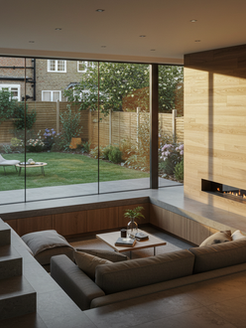A Simple Introduction from Our Experience
Owning a listed building is a unique privilege. It means you are the custodian of a property with special architectural or historic significance, a tangible piece of our national heritage. This custodianship also brings a profound responsibility to ensure any changes are made sensitively and with respect for the building's character.
The formal process for managing this change is called Listed Building Consent (LBC). It is a legal requirement designed to protect our most precious historic assets from inappropriate alterations. At London Extend, we have extensive experience in navigating this delicate process, balancing our clients' aspirations for a modern home with the vital need to protect and enhance its historic fabric. This guide will walk you through what you need to know.
The Concept in Plain English: What is Listed Building Consent?
Listed Building Consent is a special type of permission you must obtain from your local council before you can carry out any works that might affect the character of a listed property.
It is crucial to understand that LBC is entirely separate from planning permission. Many minor internal works that would never normally require planning permission—such as changing internal doors, replacing fireplaces, or altering historic plasterwork—will almost certainly require Listed Building Consent. Often, for a single project like an extension, you will need to submit two separate applications: one for planning permission and one for LBC.
It is a common and costly mistake to assume that your standard Permitted Development Rights apply to a listed building. While some of these rights technically exist, they do not in any way remove the legal obligation to apply for LBC for any works that affect the building's special character.
Key Questions Every Listed Building Owner Must Ask
Before you plan any work, you need to be certain about two things.
1. Is My Property Actually Listed? Most owners are aware of their property's status, but it's essential to be certain. You can easily check this using the official National Heritage List for England, a searchable database managed by Historic England. This will also tell you the building's grade (Grade II, Grade II*, or Grade I), which indicates its level of significance.
Crucially, the listing protects the entire building, both inside and out. It can also extend to its "curtilage," which may include outbuildings, garden walls, and other structures that were historically part of the property, even if they are not specifically mentioned in the listing description.
2. Do My Proposed Works Require Consent? The law states that LBC is required for any "works of demolition, alteration or extension... that have the potential to affect its special character." This is a deliberately broad definition. Even seemingly minor works, like replacing skirting boards with a different profile or installing new light fittings in a historic ceiling, could be deemed to affect that character.
Our advice is simple: if you have even the slightest doubt, you should assume consent is required. The safest course of action is always to apply. A key point to remember is that there is no council fee to apply for Listed Building Consent. If the council agrees that the works are minor and cause no harm, they will issue the consent promptly. It is a free and effective way to ensure you are acting lawfully.
The Serious Consequences of Getting it Wrong
The planning system treats unauthorised works to listed buildings with the utmost severity. We cannot stress this enough: carrying out works that require LBC without first securing that consent is a criminal offence.
The penalties can be life-changing and are not to be underestimated. The maximum penalty is two years' imprisonment or an unlimited fine. Furthermore, the council will almost certainly issue an Enforcement Notice requiring you to reverse all the unauthorised changes, at your own expense. As the current owner of the property, you are ultimately held responsible for any unlawful works, even those carried out by previous owners.
Our Concluding Advice: A Proactive and Respectful Approach
The key to a successful project involving a listed building is a proactive, respectful, and collaborative approach. We always recommend engaging with your local council's Conservation Officer at the earliest possible stage, often through formal pre-application advice.
At London Extend, our role is to act as your expert intermediary in this process. We prepare detailed Heritage Impact Assessments and meticulously considered architectural drawings that justify the proposed changes. We build a robust case to demonstrate how your project can be achieved whilst respecting and preserving the building's unique character.
If you are contemplating changes to your listed property, please get in touch. Managing this process correctly from the start is the only way to protect both your investment and our shared heritage.
Feeling Inspired?
Let's Bring Your Vision to Life.
Seeing a finished project is the perfect way to imagine the potential locked within your own home. The journey from an initial idea to a beautiful, functional space is one we are passionate about guiding our clients through.
At London Extend, we specialise in turning that inspiration into a well-planned, expertly managed reality. Whether you're dreaming of a light-filled kitchen extension, a clever loft conversion, or a complete home transformation, our role is to handle the architectural design and complex planning processes for you. We provide the clarity, expertise, and support needed to navigate every step with confidence, ensuring your project is not only beautifully designed but also seamlessly approved.
If these projects have sparked an idea, we'd love to hear it. Contact us today for a complimentary consultation to discuss how we can help you begin your own success story.
































